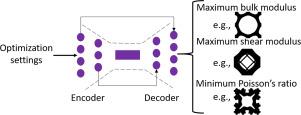当前位置:
X-MOL 学术
›
Mater. Des.
›
论文详情
Our official English website, www.x-mol.net, welcomes your
feedback! (Note: you will need to create a separate account there.)
Deep learning for topology optimization of 2D metamaterials
Materials & Design ( IF 7.6 ) Pub Date : 2020-11-01 , DOI: 10.1016/j.matdes.2020.109098 Hunter T. Kollmann , Diab W. Abueidda , Seid Koric , Erman Guleryuz , Nahil A. Sobh
Materials & Design ( IF 7.6 ) Pub Date : 2020-11-01 , DOI: 10.1016/j.matdes.2020.109098 Hunter T. Kollmann , Diab W. Abueidda , Seid Koric , Erman Guleryuz , Nahil A. Sobh

|
Abstract Data-driven models are rising as an auspicious method for the geometrical design of materials and structural systems. Nevertheless, existing data-driven models customarily address the optimization of structural designs rather than metamaterial designs. Metamaterials are emerging as promising materials exhibiting tailorable and unprecedented properties for a wide spectrum of applications. In this paper, we develop a deep learning (DL) model based on a convolutional neural network (CNN) that predicts optimal metamaterial designs. The developed DL model non-iteratively optimizes metamaterials for either maximizing the bulk modulus, maximizing the shear modulus, or minimizing the Poisson's ratio (including negative values). The data are generated by solving a large set of inverse homogenization boundary values problems, with randomly generated geometrical features from a specific distribution. Such s data-driven model can play a vital role in accelerating more computationally expensive design problems, such as multiscale metamaterial systems.
中文翻译:

用于二维超材料拓扑优化的深度学习
摘要 数据驱动模型正在成为材料和结构系统几何设计的一种吉祥方法。然而,现有的数据驱动模型通常解决结构设计的优化问题,而不是超材料设计。超材料正在成为有前途的材料,具有可定制的和前所未有的特性,适用于广泛的应用。在本文中,我们开发了一种基于卷积神经网络 (CNN) 的深度学习 (DL) 模型,该模型可预测最佳超材料设计。开发的 DL 模型非迭代优化超材料,以最大化体积模量、最大化剪切模量或最小化泊松比(包括负值)。数据是通过解决大量逆均质化边界值问题生成的,具有来自特定分布的随机生成的几何特征。这种数据驱动模型可以在加速计算成本更高的设计问题(例如多尺度超材料系统)方面发挥重要作用。
更新日期:2020-11-01
中文翻译:

用于二维超材料拓扑优化的深度学习
摘要 数据驱动模型正在成为材料和结构系统几何设计的一种吉祥方法。然而,现有的数据驱动模型通常解决结构设计的优化问题,而不是超材料设计。超材料正在成为有前途的材料,具有可定制的和前所未有的特性,适用于广泛的应用。在本文中,我们开发了一种基于卷积神经网络 (CNN) 的深度学习 (DL) 模型,该模型可预测最佳超材料设计。开发的 DL 模型非迭代优化超材料,以最大化体积模量、最大化剪切模量或最小化泊松比(包括负值)。数据是通过解决大量逆均质化边界值问题生成的,具有来自特定分布的随机生成的几何特征。这种数据驱动模型可以在加速计算成本更高的设计问题(例如多尺度超材料系统)方面发挥重要作用。











































 京公网安备 11010802027423号
京公网安备 11010802027423号